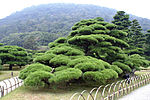| Ritsurin Garden | |
|---|---|
| Ritsurin Kōen (栗林公園) | |
 View from hill, with Mt. Shiun in background View from hill, with Mt. Shiun in background
| |
| Type | Japanese garden |
| Location | Takamatsu, Japan |
| Coordinates | 34°19′47″N 134°02′38″E / 34.329591°N 134.043968°E / 34.329591; 134.043968 |
| Area | 75 ha |
| Created | 1625 |
Ritsurin Garden (栗林公園, Ritsurin Kōen) is a large, historic garden in Takamatsu, Japan. It was completed in 1745 as a private strolling garden and villa for the local feudal lords, and opened to the public in 1875. Ritsurin is one of the largest strolling gardens in Japan, and a major tourist attraction for Kagawa Prefecture.
Ritsurin Garden lies in a former river bed on the east side of Mt. Shiun. Numerous ponds and small artificial hills dot the garden. The southern portion is in traditional Japanese style, with historic teahouses and numerous shaped pine trees. After becoming a public garden in 1875, the north portion underwent Western-style redesigns, and a large museum (currently the multipurpose Commerce and Industry Promotion Hall) and folk craft galleries were built in the center of the garden. For a time, the garden even housed a zoo and swimming pool, since closed and removed.
History
The buildings in the garden date back to the early 17th century. In 1625, the feudal lord of Takamatsu in Sanuki Province, Ikoma Takatoshi, began construction of Ritsurin, specifically the building of a garden around the South Pond using the beautiful greenery of Mt. Shiun ("Purple Cloud Mountain") as a backdrop. After Matsudaira Yorishige took control of the province, he continued the garden's construction. Work was completed by the Fifth Lord Yoritaka in 1745 after 100 years of improvements and extensions made by successive lords.
The new Meiji government came to power in 1868 and requisitioned the garden. Despite an initial proposal to build a silk mill, Ritsurin was designated a prefectural garden and opened to the public on 16 March 1875. In 1953, the garden was designated a Special Place of Scenic Beauty.
Features
The garden covers 750,000 square meters. Among the features of the garden are:
- Kikugetsu-tei (Moon Scooping Pavilion): This teahouse located in the southern section of the garden was built in the early years of the Edo period (around 1640).
- Hakomatsu: Carefully cultivated black pine trees; their branches, twigs, and needles are elaborately trimmed into geometrical shapes and figures.
- Hiraiho and Fuyō-ho: two artificial mountains
- Wild Duck Hunting Moat
- Sai-ko (Western Lake)
- Nan-ko (Southern Lake)
The many ponds and streams are full of koi, sometimes fed by visitors.
Gallery
Access
- JR Shikoku: Kōtoku Line, Ritsurin-Kōen-Kitaguchi Station
- Takamatsu-Kotohira Electric Railroad (Kotoden): Ritsurin-Kōen Station
- Kotoden Bus: Ritsurin Kōen Mae stop
- Kōsoku Bus Ritsurin Kōen Mae stop
See also
References
- "History of Ritsurin Garden [栗林公園の歴史]" (in Japanese). Kagawa Prefecture. Retrieved 13 April 2021.
- "Ritsurin Garden, special place of scenic beauty" (in Japanese). Kagawa Prefecture. Retrieved 13 April 2021.
- "Kagawa Prefecture Tourist Survey [令和元(2019)年香川県観光客動態調査報告]" (in Japanese). Kagawa Prefecture. 2019. p. 9. Retrieved 12 April 2021.
- ^ Mikuriya, Yoshimichi (2013). "A Brief History of Ritsurin Garden". Pictorial Record of Ritsurin Garden. Japan: Kagawa Prefectural Ritsurin Garden Tourism Office. pp. 16–18.
- Kagawa reserve cultural assets investigation center (2006-03-31). "栗林公園". Comprehensive Database of Archaeological Site Reports in Japan. Retrieved 2016-09-02.
- Mansfield. Page 83.
Bibliography
- Mansfield, Stephen (2011). Japan's Master Gardens - Lessons in Space and Environment (Hardback). Tokyo, Rutland, Singapore: Tuttle. ISBN 978-4-8053-1128-8.
External links
- Ritsurin Garden
- Comprehensive Database of Archaeological Site Reports in Japan, Nara National Research Institute for Cultural Properties
- 60252671 Ritsurin Garden on OpenStreetMap













